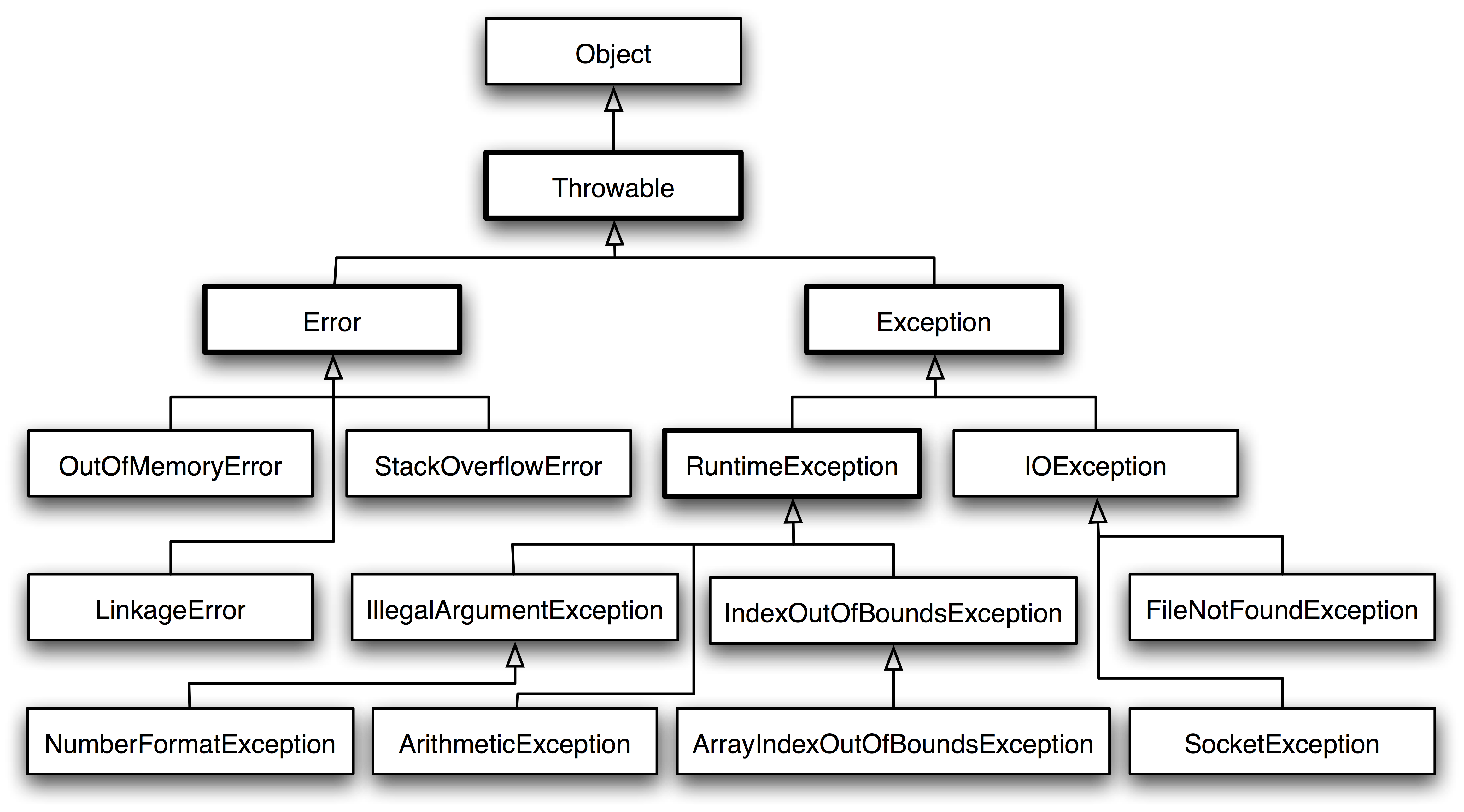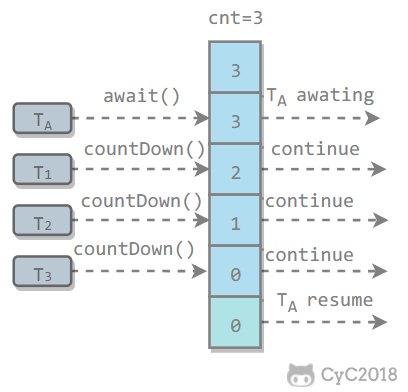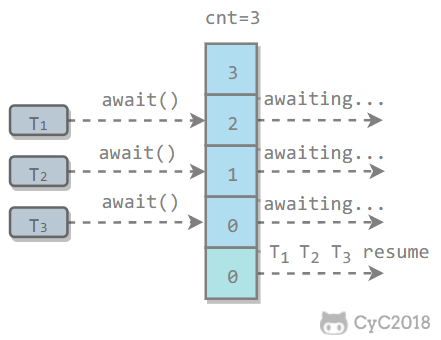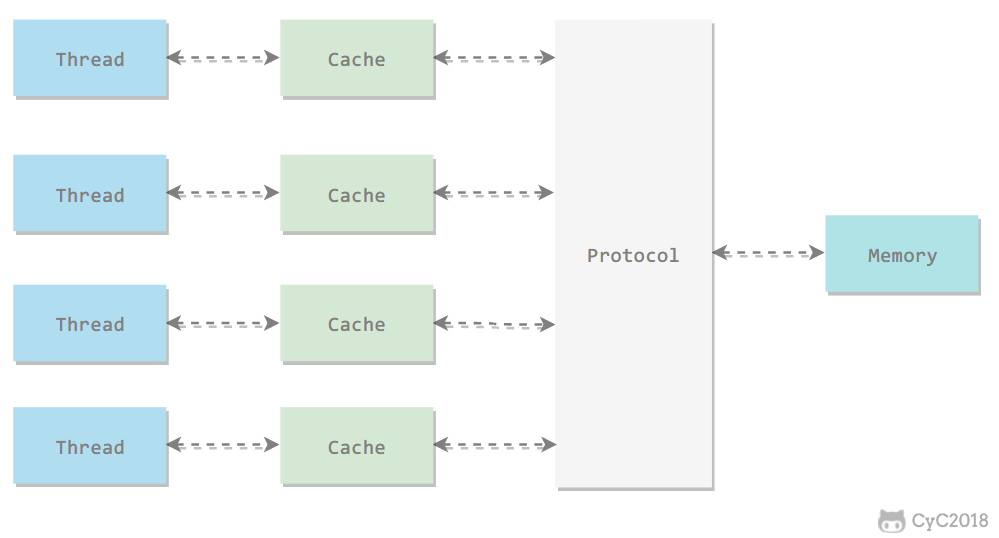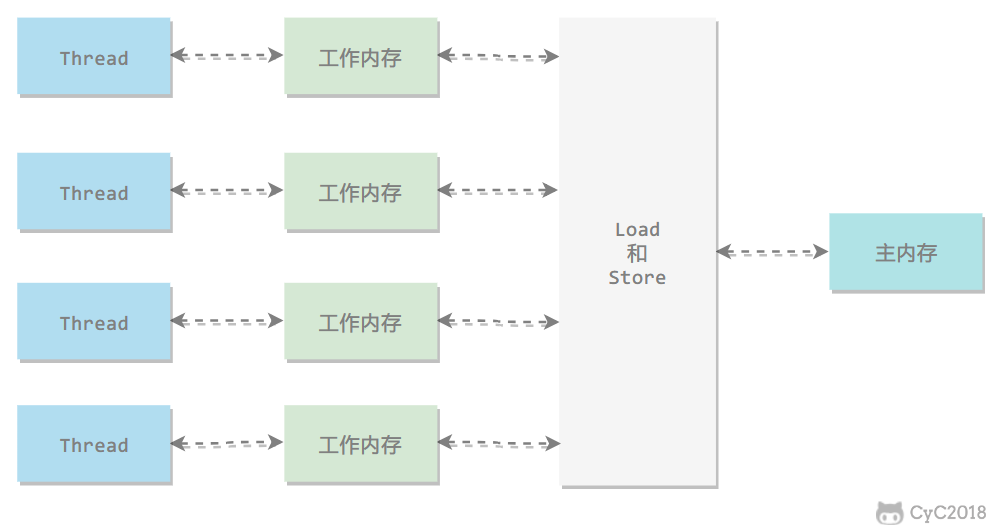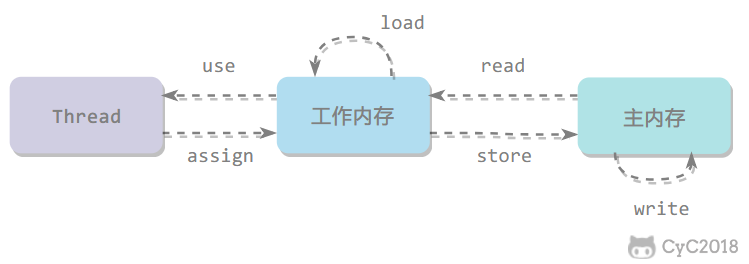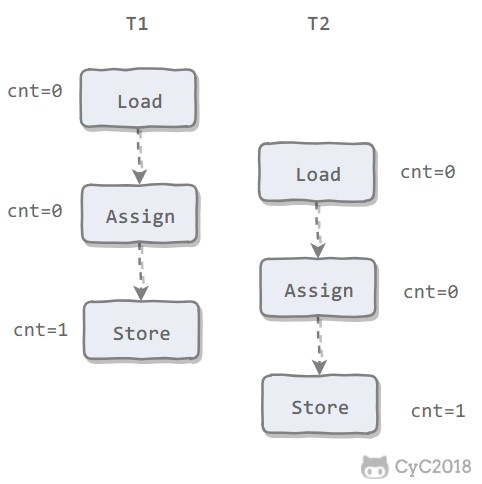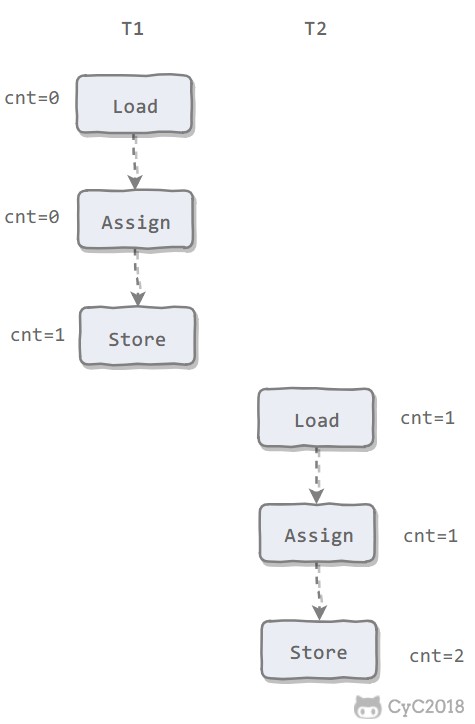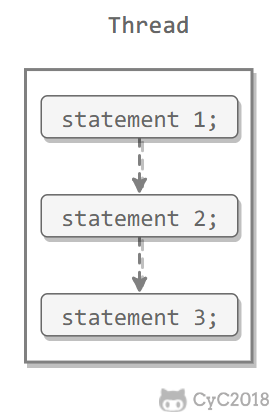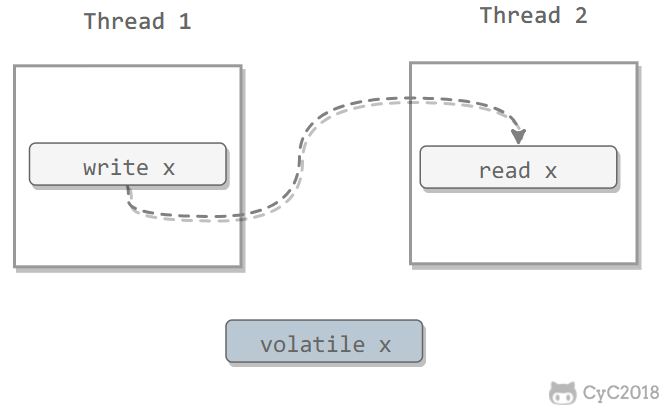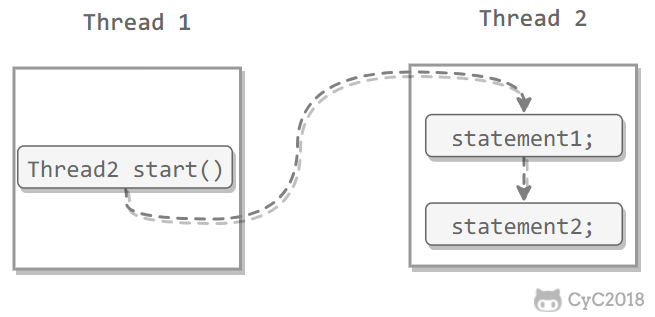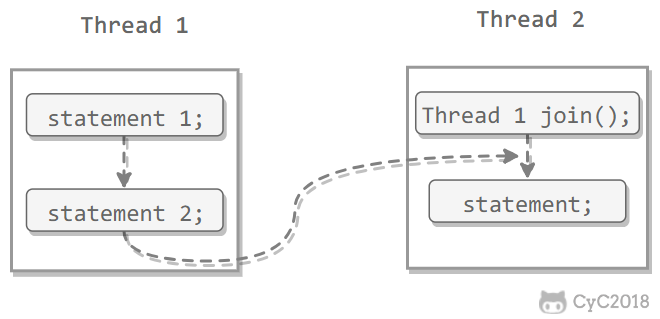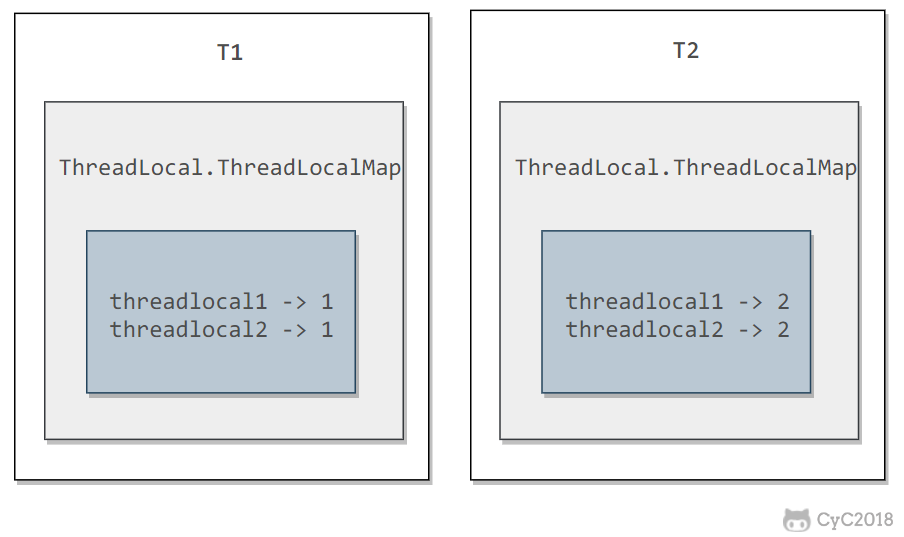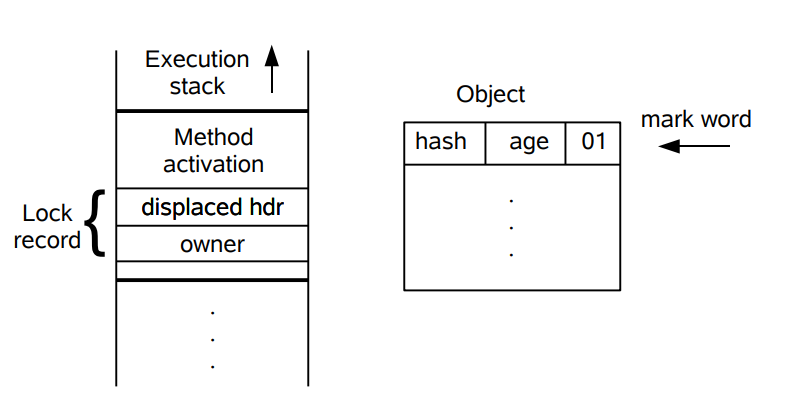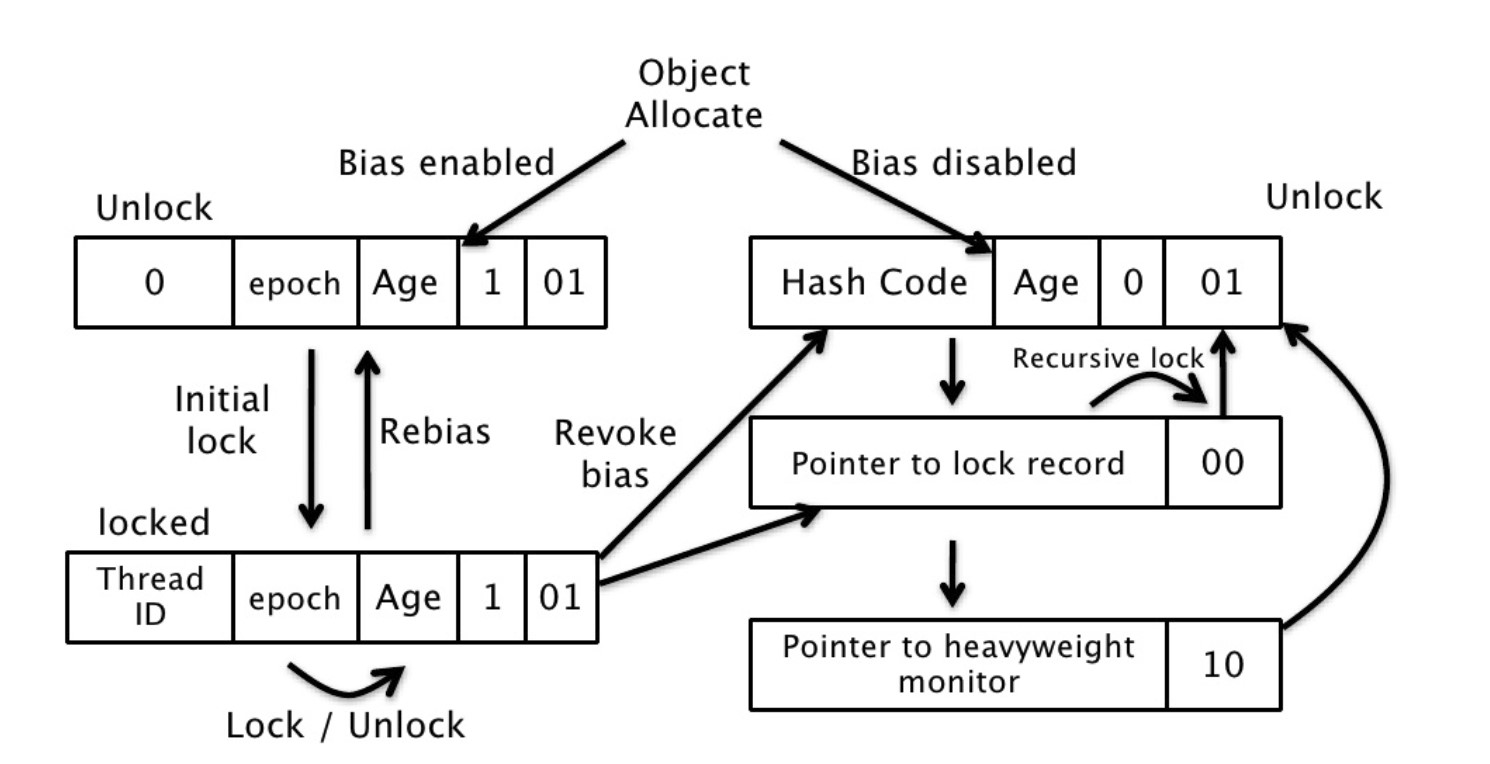Java 基础
一、数据类型 基本类型
byte/8
char/16
short/16
int/32
float/32
long/64
double/64
boolean/~
boolean 只有两个值:true、false,可以使用 1 bit 来存储,但是具体大小没有明确规定。JVM 会在编译时期将 boolean 类型的数据转换为 int,使用 1 来表示 true,0 表示 false。JVM 支持 boolean 数组,但是是通过读写 byte 数组来实现的。
包装类型 基本类型都有对应的包装类型,基本类型与其对应的包装类型之间的赋值使用自动装箱与拆箱完成。
1 2 Integer x = 2 ; int y = x;
缓存池 new Integer(123) 与 Integer.valueOf(123) 的区别在于:
new Integer(123) 每次都会新建一个对象;
Integer.valueOf(123) 会使用缓存池中的对象,多次调用会取得同一个对象的引用。
1 2 3 4 5 6 Integer x = new Integer(123 );new Integer(123 );123 );123 );
valueOf() 方法的实现比较简单,就是先判断值是否在缓存池中,如果在的话就直接返回缓存池的内容。
1 2 3 4 5 public static Integer valueOf (int i) if (i >= IntegerCache.low && i <= IntegerCache.high)return IntegerCache.cache[i + (-IntegerCache.low)];return new Integer(i);
在 Java 8 中,Integer 缓存池的大小默认为 -128~127。
1 2 3 4 5 6 7 8 9 10 11 12 13 14 15 16 17 18 19 20 21 22 23 24 25 26 27 28 29 static final int low = -128 ;static final int high;static final Integer cache[];static {int h = 127 ;"java.lang.Integer.IntegerCache.high" );if (integerCacheHighPropValue != null ) {try {int i = parseInt(integerCacheHighPropValue);127 );1 );catch ( NumberFormatException nfe) {new Integer[(high - low) + 1 ];int j = low;for (int k = 0 ; k < cache.length; k++)new Integer(j++);assert IntegerCache.high >= 127 ;
编译器会在自动装箱过程调用 valueOf() 方法,因此多个值相同且值在缓存池范围内的 Integer 实例使用自动装箱来创建,那么就会引用相同的对象。
1 2 3 Integer m = 123 ;123 ;
基本类型对应的缓冲池如下:
boolean values true and false
all byte values
short values between -128 and 127
int values between -128 and 127
char in the range \u0000 to \u007F
在使用这些基本类型对应的包装类型时,如果该数值范围在缓冲池范围内,就可以直接使用缓冲池中的对象。
在 jdk 1.8 所有的数值类缓冲池中,Integer 的缓冲池 IntegerCache 很特殊,这个缓冲池的下界是 - 128,上界默认是 127,但是这个上界是可调的,在启动 jvm 的时候,通过 -XX:AutoBoxCacheMax=<size> 来指定这个缓冲池的大小,该选项在 JVM 初始化的时候会设定一个名为 java.lang.IntegerCache.high 系统属性,然后 IntegerCache 初始化的时候就会读取该系统属性来决定上界。
[StackOverflow : Differences between new Integer(123), Integer.valueOf(123) and just 123
](https://stackoverflow.com/questions/9030817/differences-between-new-integer123-integer-valueof123-and-just-123 )
二、String 概览 String 被声明为 final,因此它不可被继承。(Integer 等包装类也不能被继承)
在 Java 8 中,String 内部使用 char 数组存储数据。
1 2 3 4 5 public final class String implements java .io .Serializable , Comparable <String >, CharSequence {private final char value[];
在 Java 9 之后,String 类的实现改用 byte 数组存储字符串,同时使用 coder 来标识使用了哪种编码。
1 2 3 4 5 6 7 8 public final class String implements java .io .Serializable , Comparable <String >, CharSequence {private final byte [] value;private final byte coder;
value 数组被声明为 final,这意味着 value 数组初始化之后就不能再引用其它数组。并且 String 内部没有改变 value 数组的方法,因此可以保证 String 不可变。
不可变的好处 1. 可以缓存 hash 值
因为 String 的 hash 值经常被使用,例如 String 用做 HashMap 的 key。不可变的特性可以使得 hash 值也不可变,因此只需要进行一次计算。
2. String Pool 的需要
如果一个 String 对象已经被创建过了,那么就会从 String Pool 中取得引用。只有 String 是不可变的,才可能使用 String Pool。
3. 安全性
String 经常作为参数,String 不可变性可以保证参数不可变。例如在作为网络连接参数的情况下如果 String 是可变的,那么在网络连接过程中,String 被改变,改变 String 的那一方以为现在连接的是其它主机,而实际情况却不一定是。
4. 线程安全
String 不可变性天生具备线程安全,可以在多个线程中安全地使用。
Program Creek : Why String is immutable in Java?
String, StringBuffer and StringBuilder 1. 可变性
String 不可变
StringBuffer 和 StringBuilder 可变
2. 线程安全
String 不可变,因此是线程安全的
StringBuilder 不是线程安全的
StringBuffer 是线程安全的,内部使用 synchronized 进行同步
StackOverflow : String, StringBuffer, and StringBuilder
String Pool 字符串常量池(String Pool)保存着所有字符串字面量(literal strings),这些字面量在编译时期就确定。不仅如此,还可以使用 String 的 intern() 方法在运行过程将字符串添加到 String Pool 中。
当一个字符串调用 intern() 方法时,如果 String Pool 中已经存在一个字符串和该字符串值相等(使用 equals() 方法进行确定),那么就会返回 String Pool 中字符串的引用;否则,就会在 String Pool 中添加一个新的字符串,并返回这个新字符串的引用。
下面示例中,s1 和 s2 采用 new String() 的方式新建了两个不同字符串,而 s3 和 s4 是通过 s1.intern() 和 s2.intern() 方法取得同一个字符串引用。intern() 首先把 “aaa” 放到 String Pool 中,然后返回这个字符串引用,因此 s3 和 s4 引用的是同一个字符串。
1 2 3 4 5 6 String s1 = new String("aaa" );new String("aaa" );
如果是采用 “bbb” 这种字面量的形式创建字符串,会自动地将字符串放入 String Pool 中。
1 2 3 String s5 = "bbb" ;"bbb" ;
在 Java 7 之前,String Pool 被放在运行时常量池中,它属于永久代。而在 Java 7,String Pool 被移到堆中。这是因为永久代的空间有限,在大量使用字符串的场景下会导致 OutOfMemoryError 错误。
new String(“abc”) 使用这种方式一共会创建两个字符串对象(前提是 String Pool 中还没有 “abc” 字符串对象)。
“abc” 属于字符串字面量,因此编译时期会在 String Pool 中创建一个字符串对象,指向这个 “abc” 字符串字面量;
而使用 new 的方式会在堆中创建一个字符串对象。
创建一个测试类,其 main 方法中使用这种方式来创建字符串对象。
1 2 3 4 5 public class NewStringTest public static void main (String[] args) new String("abc" );
使用 javap -verbose 进行反编译,得到以下内容:
1 2 3 4 5 6 7 8 9 10 11 12 13 14 15 16 17 18 19 20 21 public static void main (java.lang.String[]) 3 , locals=2 , args_size=1 3 : dup9 : astore_1
在 Constant Pool 中,#19 存储这字符串字面量 “abc”,#3 是 String Pool 的字符串对象,它指向 #19 这个字符串字面量。在 main 方法中,0: 行使用 new #2 在堆中创建一个字符串对象,并且使用 ldc #3 将 String Pool 中的字符串对象作为 String 构造函数的参数。
以下是 String 构造函数的源码,可以看到,在将一个字符串对象作为另一个字符串对象的构造函数参数时,并不会完全复制 value 数组内容,而是都会指向同一个 value 数组。
1 2 3 4 public String (String original) this .value = original.value;this .hash = original.hash;
三、运算 参数传递 Java 的参数是以值传递的形式传入方法中,而不是引用传递。
以下代码中 Dog dog 的 dog 是一个指针,存储的是对象的地址。在将一个参数传入一个方法时,本质上是将对象的地址以值的方式传递到形参中。
1 2 3 4 5 6 7 8 9 10 11 12 13 14 15 16 17 18 19 20 public class Dog this .name = name;String getName () {return this .name;void setName (String name) this .name = name;String getObjectAddress () {return super .toString();
在方法中改变对象的字段值会改变原对象该字段值,因为引用的是同一个对象。
1 2 3 4 5 6 7 8 9 10 11 class PassByValueExample public static void main (String[] args) new Dog("A" );private static void func (Dog dog) "B" );
但是在方法中将指针引用了其它对象,那么此时方法里和方法外的两个指针指向了不同的对象,在一个指针改变其所指向对象的内容对另一个指针所指向的对象没有影响。
1 2 3 4 5 6 7 8 9 10 11 12 13 14 15 16 public class PassByValueExample public static void main (String[] args) new Dog("A" );private static void func (Dog dog) new Dog("B" );
StackOverflow: Is Java “pass-by-reference” or “pass-by-value”?
float 与 double Java 不能隐式执行向下转型,因为这会使得精度降低。
1.1 字面量属于 double 类型,不能直接将 1.1 直接赋值给 float 变量,因为这是向下转型。
1.1f 字面量才是 float 类型。
隐式类型转换 因为字面量 1 是 int 类型,它比 short 类型精度要高,因此不能隐式地将 int 类型向下转型为 short 类型。
但是使用 += 或者 ++ 运算符会执行隐式类型转换。
上面的语句相当于将 s1 + 1 的计算结果进行了向下转型:
StackOverflow : Why don’t Java’s +=, -=, *=, /= compound assignment operators require casting?
switch 从 Java 7 开始,可以在 switch 条件判断语句中使用 String 对象。
1 2 3 4 5 6 7 8 9 String s = "a" ;switch (s) {case "a" :"aaa" );break ;case "b" :"bbb" );break ;
switch 不支持 long、float、double,是因为 switch 的设计初衷是对那些只有少数几个值的类型进行等值判断,如果值过于复杂,那么还是用 if 比较合适。
StackOverflow : Why can’t your switch statement data type be long, Java?
四、关键字 final 1. 数据
声明数据为常量,可以是编译时常量,也可以是在运行时被初始化后不能被改变的常量。
对于基本类型,final 使数值不变;
对于引用类型,final 使引用不变,也就不能引用其它对象,但是被引用的对象本身是可以修改的。
1 2 3 4 final int x = 1 ;final A y = new A();1 ;
2. 方法
声明方法不能被子类重写。
private 方法隐式地被指定为 final,如果在子类中定义的方法和基类中的一个 private 方法签名相同,此时子类的方法不是重写基类方法,而是在子类中定义了一个新的方法。
3. 类
声明类不允许被继承。
static 1. 静态变量
静态变量:又称为类变量,也就是说这个变量属于类的,类所有的实例都共享静态变量,可以直接通过类名来访问它。静态变量在内存中只存在一份。
实例变量:每创建一个实例就会产生一个实例变量,它与该实例同生共死。
1 2 3 4 5 6 7 8 9 10 11 12 public class A private int x; private static int y; public static void main (String[] args) new A();int x = a.x;int y = A.y;
2. 静态方法
静态方法在类加载的时候就存在了,它不依赖于任何实例。所以静态方法必须有实现,也就是说它不能是抽象方法。
1 2 3 4 5 public abstract class A public static void func1 ()
只能访问所属类的静态字段和静态方法,方法中不能有 this 和 super 关键字,因为这两个关键字与具体对象关联。
1 2 3 4 5 6 7 8 9 10 11 public class A private static int x;private int y;public static void func1 () int a = x;
3. 静态语句块
静态语句块在类初始化时运行一次。
1 2 3 4 5 6 7 8 9 10 public class A static {"123" );public static void main (String[] args) new A();new A();
4. 静态内部类
非静态内部类依赖于外部类的实例,也就是说需要先创建外部类实例,才能用这个实例去创建非静态内部类。而静态内部类不需要。
1 2 3 4 5 6 7 8 9 10 11 12 13 14 15 public class OuterClass class InnerClass static class StaticInnerClass public static void main (String[] args) new OuterClass();new InnerClass () ;new StaticInnerClass();
静态内部类不能访问外部类的非静态的变量和方法。
5. 静态导包
在使用静态变量和方法时不用再指明 ClassName,从而简化代码,但可读性大大降低。
1 import static com.xxx.ClassName.*
6. 初始化顺序
静态变量和静态语句块优先于实例变量和普通语句块,静态变量和静态语句块的初始化顺序取决于它们在代码中的顺序。
1 public static String staticField = "静态变量" ;
1 2 3 static {"静态语句块" );
1 public String field = "实例变量" ;
1 2 3 {"普通语句块" );
最后才是构造函数的初始化。
1 2 3 public InitialOrderTest () "构造函数" );
存在继承的情况下,初始化顺序为:
父类(静态变量、静态语句块)
子类(静态变量、静态语句块)
父类(实例变量、普通语句块)
父类(构造函数)
子类(实例变量、普通语句块)
子类(构造函数)
五、Object 通用方法 概览 1 2 3 4 5 6 7 8 9 10 11 12 13 14 15 16 17 18 19 20 21 public native int hashCode () public boolean equals (Object obj) protected native Object clone () throws CloneNotSupportedExceptionpublic String toString () public final native Class<?> getClass () protected void finalize () throws Throwable public final native void notify () public final native void notifyAll () public final native void wait (long timeout) throws InterruptedExceptionpublic final void wait (long timeout, int nanos) throws InterruptedExceptionpublic final void wait () throws InterruptedException
equals() 1. 等价关系
两个对象具有等价关系,需要满足以下五个条件:
Ⅰ 自反性
Ⅱ 对称性
1 x.equals(y) == y.equals(x);
Ⅲ 传递性
1 2 if (x.equals(y) && y.equals(z))
Ⅳ 一致性
多次调用 equals() 方法结果不变
1 x.equals(y) == x.equals(y);
Ⅴ 与 null 的比较
对任何不是 null 的对象 x 调用 x.equals(null) 结果都为 false
2. 等价与相等
对于基本类型,== 判断两个值是否相等,基本类型没有 equals() 方法。
对于引用类型,== 判断两个变量是否引用同一个对象,而 equals() 判断引用的对象是否等价。
1 2 3 4 Integer x = new Integer(1 );new Integer(1 );
3. 实现
检查是否为同一个对象的引用,如果是直接返回 true;
检查是否是同一个类型,如果不是,直接返回 false;
将 Object 对象进行转型;
判断每个关键域是否相等。
1 2 3 4 5 6 7 8 9 10 11 12 13 14 15 16 17 18 19 20 21 22 23 24 public class EqualExample private int x;private int y;private int z;public EqualExample (int x, int y, int z) this .x = x;this .y = y;this .z = z;@Override public boolean equals (Object o) if (this == o) return true ;if (o == null || getClass() != o.getClass()) return false ;if (x != that.x) return false ;if (y != that.y) return false ;return z == that.z;
hashCode() hashCode() 返回哈希值,而 equals() 是用来判断两个对象是否等价。等价的两个对象散列值一定相同,但是散列值相同的两个对象不一定等价,这是因为计算哈希值具有随机性,两个值不同的对象可能计算出相同的哈希值。
在覆盖 equals() 方法时应当总是覆盖 hashCode() 方法,保证等价的两个对象哈希值也相等。
HashSet 和 HashMap 等集合类使用了 hashCode() 方法来计算对象应该存储的位置,因此要将对象添加到这些集合类中,需要让对应的类实现 hashCode() 方法。
下面的代码中,新建了两个等价的对象,并将它们添加到 HashSet 中。我们希望将这两个对象当成一样的,只在集合中添加一个对象。但是 EqualExample 没有实现 hashCode() 方法,因此这两个对象的哈希值是不同的,最终导致集合添加了两个等价的对象。
1 2 3 4 5 6 7 EqualExample e1 = new EqualExample(1 , 1 , 1 );new EqualExample(1 , 1 , 1 );new HashSet<>();
理想的哈希函数应当具有均匀性,即不相等的对象应当均匀分布到所有可能的哈希值上。这就要求了哈希函数要把所有域的值都考虑进来。可以将每个域都当成 R 进制的某一位,然后组成一个 R 进制的整数。
R 一般取 31,因为它是一个奇素数,如果是偶数的话,当出现乘法溢出,信息就会丢失,因为与 2 相乘相当于向左移一位,最左边的位丢失。并且一个数与 31 相乘可以转换成移位和减法:31*x == (x<<5)-x,编译器会自动进行这个优化。
1 2 3 4 5 6 7 8 @Override public int hashCode () int result = 17 ;31 * result + x;31 * result + y;31 * result + z;return result;
toString() 默认返回 ToStringExample@4554617c 这种形式,其中 @ 后面的数值为散列码的无符号十六进制表示。
1 2 3 4 5 6 7 8 public class ToStringExample private int number;public ToStringExample (int number) this .number = number;
1 2 ToStringExample example = new ToStringExample(123 );
1 ToStringExample@4554617c
clone() 1. cloneable
clone() 是 Object 的 protected 方法,它不是 public,一个类不显式去重写 clone(),其它类就不能直接去调用该类实例的 clone() 方法。
1 2 3 4 public class CloneExample private int a;private int b;
1 2 CloneExample e1 = new CloneExample();
重写 clone() 得到以下实现:
1 2 3 4 5 6 7 8 9 public class CloneExample private int a;private int b;@Override public CloneExample clone () throws CloneNotSupportedException return (CloneExample)super .clone();
1 2 3 4 5 6 CloneExample e1 = new CloneExample();try {catch (CloneNotSupportedException e) {
1 java.lang.CloneNotSupportedException: CloneExample
以上抛出了 CloneNotSupportedException,这是因为 CloneExample 没有实现 Cloneable 接口。
应该注意的是,clone() 方法并不是 Cloneable 接口的方法,而是 Object 的一个 protected 方法。Cloneable 接口只是规定,如果一个类没有实现 Cloneable 接口又调用了 clone() 方法,就会抛出 CloneNotSupportedException。
1 2 3 4 5 6 7 8 9 public class CloneExample implements Cloneable private int a;private int b;@Override public Object clone () throws CloneNotSupportedException return super .clone();
2. 浅拷贝
拷贝对象和原始对象的引用类型引用同一个对象。
1 2 3 4 5 6 7 8 9 10 11 12 13 14 15 16 17 18 19 20 21 22 23 24 public class ShallowCloneExample implements Cloneable private int [] arr;public ShallowCloneExample () new int [10 ];for (int i = 0 ; i < arr.length; i++) {public void set (int index, int value) public int get (int index) return arr[index];@Override protected ShallowCloneExample clone () throws CloneNotSupportedException return (ShallowCloneExample) super .clone();
1 2 3 4 5 6 7 8 9 ShallowCloneExample e1 = new ShallowCloneExample();null ;try {catch (CloneNotSupportedException e) {2 , 222 );2 ));
3. 深拷贝
拷贝对象和原始对象的引用类型引用不同对象。
1 2 3 4 5 6 7 8 9 10 11 12 13 14 15 16 17 18 19 20 21 22 23 24 25 26 27 28 29 public class DeepCloneExample implements Cloneable private int [] arr;public DeepCloneExample () new int [10 ];for (int i = 0 ; i < arr.length; i++) {public void set (int index, int value) public int get (int index) return arr[index];@Override protected DeepCloneExample clone () throws CloneNotSupportedException super .clone();new int [arr.length];for (int i = 0 ; i < arr.length; i++) {return result;
1 2 3 4 5 6 7 8 9 DeepCloneExample e1 = new DeepCloneExample();null ;try {catch (CloneNotSupportedException e) {2 , 222 );2 ));
4. clone() 的替代方案
使用 clone() 方法来拷贝一个对象即复杂又有风险,它会抛出异常,并且还需要类型转换。Effective Java 书上讲到,最好不要去使用 clone(),可以使用拷贝构造函数或者拷贝工厂来拷贝一个对象。
1 2 3 4 5 6 7 8 9 10 11 12 13 14 15 16 17 18 19 20 21 22 23 24 25 26 public class CloneConstructorExample private int [] arr;public CloneConstructorExample () new int [10 ];for (int i = 0 ; i < arr.length; i++) {public CloneConstructorExample (CloneConstructorExample original) new int [original.arr.length];for (int i = 0 ; i < original.arr.length; i++) {public void set (int index, int value) public int get (int index) return arr[index];
1 2 3 4 CloneConstructorExample e1 = new CloneConstructorExample();new CloneConstructorExample(e1);2 , 222 );2 ));
六、继承 访问权限 Java 中有三个访问权限修饰符:private、protected 以及 public,如果不加访问修饰符,表示包级可见。
可以对类或类中的成员(字段和方法)加上访问修饰符。
类可见表示其它类可以用这个类创建实例对象。
成员可见表示其它类可以用这个类的实例对象访问到该成员;
protected 用于修饰成员,表示在继承体系中成员对于子类可见,但是这个访问修饰符对于类没有意义。
设计良好的模块会隐藏所有的实现细节,把它的 API 与它的实现清晰地隔离开来。模块之间只通过它们的 API 进行通信,一个模块不需要知道其他模块的内部工作情况,这个概念被称为信息隐藏或封装。因此访问权限应当尽可能地使每个类或者成员不被外界访问。
如果子类的方法重写了父类的方法,那么子类中该方法的访问级别不允许低于父类的访问级别。这是为了确保可以使用父类实例的地方都可以使用子类实例去代替,也就是确保满足里氏替换原则。
字段决不能是公有的,因为这么做的话就失去了对这个字段修改行为的控制,客户端可以对其随意修改。例如下面的例子中,AccessExample 拥有 id 公有字段,如果在某个时刻,我们想要使用 int 存储 id 字段,那么就需要修改所有的客户端代码。
1 2 3 public class AccessExample public String id;
可以使用公有的 getter 和 setter 方法来替换公有字段,这样的话就可以控制对字段的修改行为。
1 2 3 4 5 6 7 8 9 10 11 12 public class AccessExample private int id;public String getId () return id + "" ;public void setId (String id) this .id = Integer.valueOf(id);
但是也有例外,如果是包级私有的类或者私有的嵌套类,那么直接暴露成员不会有特别大的影响。
1 2 3 4 5 6 7 8 9 10 11 12 13 14 15 16 public class AccessWithInnerClassExample private class InnerClass int x;private InnerClass innerClass;public AccessWithInnerClassExample () new InnerClass();public int getValue () return innerClass.x;
抽象类与接口 1. 抽象类
抽象类和抽象方法都使用 abstract 关键字进行声明。如果一个类中包含抽象方法,那么这个类必须声明为抽象类。
抽象类和普通类最大的区别是,抽象类不能被实例化,只能被继承。
1 2 3 4 5 6 7 8 9 10 11 public abstract class AbstractClassExample protected int x;private int y;public abstract void func1 () public void func2 () "func2" );
1 2 3 4 5 6 public class AbstractExtendClassExample extends AbstractClassExample @Override public void func1 () "func1" );
1 2 3 new AbstractExtendClassExample();
2. 接口
接口是抽象类的延伸,在 Java 8 之前,它可以看成是一个完全抽象的类,也就是说它不能有任何的方法实现。
从 Java 8 开始,接口也可以拥有默认的方法实现,这是因为不支持默认方法的接口的维护成本太高了。在 Java 8 之前,如果一个接口想要添加新的方法,那么要修改所有实现了该接口的类,让它们都实现新增的方法。
接口的成员(字段 + 方法)默认都是 public 的,并且不允许定义为 private 或者 protected。从 Java 9 开始,允许将方法定义为 private,这样就能定义某些复用的代码又不会把方法暴露出去。
接口的字段默认都是 static 和 final 的。
1 2 3 4 5 6 7 8 9 10 11 12 13 14 15 public interface InterfaceExample void func1 () default void func2 () "func2" );int x = 123 ;public int z = 0 ;
1 2 3 4 5 6 public class InterfaceImplementExample implements InterfaceExample @Override public void func1 () "func1" );
1 2 3 4 new InterfaceImplementExample();
3. 比较
从设计层面上看,抽象类提供了一种 IS-A 关系,需要满足里式替换原则,即子类对象必须能够替换掉所有父类对象。而接口更像是一种 LIKE-A 关系,它只是提供一种方法实现契约,并不要求接口和实现接口的类具有 IS-A 关系。
从使用上来看,一个类可以实现多个接口,但是不能继承多个抽象类。
接口的字段只能是 static 和 final 类型的,而抽象类的字段没有这种限制。
接口的成员只能是 public 的,而抽象类的成员可以有多种访问权限。
4. 使用选择
使用接口:
需要让不相关的类都实现一个方法,例如不相关的类都可以实现 Comparable 接口中的 compareTo() 方法;
需要使用多重继承。
使用抽象类:
需要在几个相关的类中共享代码。
需要能控制继承来的成员的访问权限,而不是都为 public。
需要继承非静态和非常量字段。
在很多情况下,接口优先于抽象类。因为接口没有抽象类严格的类层次结构要求,可以灵活地为一个类添加行为。并且从 Java 8 开始,接口也可以有默认的方法实现,使得修改接口的成本也变的很低。
super
访问父类的构造函数:可以使用 super() 函数访问父类的构造函数,从而委托父类完成一些初始化的工作。应该注意到,子类一定会调用父类的构造函数来完成初始化工作,一般是调用父类的默认构造函数,如果子类需要调用父类其它构造函数,那么就可以使用 super() 函数。
访问父类的成员:如果子类重写了父类的某个方法,可以通过使用 super 关键字来引用父类的方法实现。
1 2 3 4 5 6 7 8 9 10 11 12 13 14 public class SuperExample protected int x;protected int y;public SuperExample (int x, int y) this .x = x;this .y = y;public void func () "SuperExample.func()" );
1 2 3 4 5 6 7 8 9 10 11 12 13 14 15 public class SuperExtendExample extends SuperExample private int z;public SuperExtendExample (int x, int y, int z) super (x, y);this .z = z;@Override public void func () super .func();"SuperExtendExample.func()" );
1 2 SuperExample e = new SuperExtendExample(1 , 2 , 3 );
1 2 SuperExample.func()
Using the Keyword super
重写与重载 1. 重写(Override)
存在于继承体系中,指子类实现了一个与父类在方法声明上完全相同的一个方法。
为了满足里式替换原则,重写有以下三个限制:
子类方法的访问权限必须大于等于父类方法;
子类方法的返回类型必须是父类方法返回类型或为其子类型。
子类方法抛出的异常类型必须是父类抛出异常类型或为其子类型。
使用 @Override 注解,可以让编译器帮忙检查是否满足上面的三个限制条件。
下面的示例中,SubClass 为 SuperClass 的子类,SubClass 重写了 SuperClass 的 func() 方法。其中:
子类方法访问权限为 public,大于父类的 protected。
子类的返回类型为 ArrayList<Integer>,是父类返回类型 List<Integer> 的子类。
子类抛出的异常类型为 Exception,是父类抛出异常 Throwable 的子类。
子类重写方法使用 @Override 注解,从而让编译器自动检查是否满足限制条件。
1 2 3 4 5 6 7 8 9 10 11 12 class SuperClass protected List<Integer> func () throws Throwable return new ArrayList<>();class SubClass extends SuperClass @Override public ArrayList<Integer> func () throws Exception return new ArrayList<>();
在调用一个方法时,先从本类中查找看是否有对应的方法,如果没有再到父类中查看,看是否从父类继承来。否则就要对参数进行转型,转成父类之后看是否有对应的方法。总的来说,方法调用的优先级为:
this.func(this)
super.func(this)
this.func(super)
super.func(super)
1 2 3 4 5 6 7 8 9 10 11 12 13 14 15 16 17 18 19 20 21 22 23 24 25 26 27 28 29 30 31 32 33 34 35 class A public void show (A obj) "A.show(A)" );public void show (C obj) "A.show(C)" );class B extends A @Override public void show (A obj) "B.show(A)" );class C extends B class D extends C
1 2 3 4 5 6 7 8 9 10 11 12 13 14 15 16 17 18 19 20 21 public static void main (String[] args) new A();new B();new C();new D();new B();
2. 重载(Overload)
存在于同一个类中,指一个方法与已经存在的方法名称上相同,但是参数类型、个数、顺序至少有一个不同。
应该注意的是,返回值不同,其它都相同不算是重载。
1 2 3 4 5 6 7 8 9 class OverloadingExample public void show (int x) public void show (int x, String y) " " + y);
1 2 3 4 5 public static void main (String[] args) new OverloadingExample();1 );1 , "2" );
七、反射 每个类都有一个 Class 对象,包含了与类有关的信息。当编译一个新类时,会产生一个同名的 .class 文件,该文件内容保存着 Class 对象。
类加载相当于 Class 对象的加载,类在第一次使用时才动态加载到 JVM 中。也可以使用 Class.forName("com.mysql.jdbc.Driver") 这种方式来控制类的加载,该方法会返回一个 Class 对象。
反射可以提供运行时的类信息,并且这个类可以在运行时才加载进来,甚至在编译时期该类的 .class 不存在也可以加载进来。
Class 和 java.lang.reflect 一起对反射提供了支持,java.lang.reflect 类库主要包含了以下三个类:
Field :可以使用 get() 和 set() 方法读取和修改 Field 对象关联的字段;
Method :可以使用 invoke() 方法调用与 Method 对象关联的方法;
Constructor :可以用 Constructor 的 newInstance() 创建新的对象。
反射的优点:
可扩展性 :应用程序可以利用全限定名创建可扩展对象的实例,来使用来自外部的用户自定义类。
类浏览器和可视化开发环境 :一个类浏览器需要可以枚举类的成员。可视化开发环境(如 IDE)可以从利用反射中可用的类型信息中受益,以帮助程序员编写正确的代码。
调试器和测试工具 : 调试器需要能够检查一个类里的私有成员。测试工具可以利用反射来自动地调用类里定义的可被发现的 API 定义,以确保一组测试中有较高的代码覆盖率。
反射的缺点:
尽管反射非常强大,但也不能滥用。如果一个功能可以不用反射完成,那么最好就不用。在我们使用反射技术时,下面几条内容应该牢记于心。
性能开销 :反射涉及了动态类型的解析,所以 JVM 无法对这些代码进行优化。因此,反射操作的效率要比那些非反射操作低得多。我们应该避免在经常被执行的代码或对性能要求很高的程序中使用反射。
安全限制 :使用反射技术要求程序必须在一个没有安全限制的环境中运行。如果一个程序必须在有安全限制的环境中运行,如 Applet,那么这就是个问题了。
内部暴露 :由于反射允许代码执行一些在正常情况下不被允许的操作(比如访问私有的属性和方法),所以使用反射可能会导致意料之外的副作用,这可能导致代码功能失调并破坏可移植性。反射代码破坏了抽象性,因此当平台发生改变的时候,代码的行为就有可能也随着变化。
Trail: The Reflection API
深入解析 Java 反射(1)- 基础
八、异常 Throwable 可以用来表示任何可以作为异常抛出的类,分为两种: Error 和 Exception 。其中 Error 用来表示 JVM 无法处理的错误,Exception 分为两种:
受检异常 :需要用 try…catch… 语句捕获并进行处理,并且可以从异常中恢复;
非受检异常 :是程序运行时错误,例如除 0 会引发 Arithmetic Exception,此时程序崩溃并且无法恢复。
九、泛型 1 2 3 4 5 6 public class Box <T > private T t;public void set (T t) this .t = t; }public T get () return t; }
十、注解 Java 注解是附加在代码中的一些元信息,用于一些工具在编译、运行时进行解析和使用,起到说明、配置的功能。注解不会也不能影响代码的实际逻辑,仅仅起到辅助性的作用。
注解 Annotation 实现原理与自定义注解例子
十一、特性 Java 各版本的新特性 New highlights in Java SE 8
Lambda Expressions
Pipelines and Streams
Date and Time API
Default Methods
Type Annotations
Nashhorn JavaScript Engine
Concurrent Accumulators
Parallel operations
PermGen Error Removed
New highlights in Java SE 7
Strings in Switch Statement
Type Inference for Generic Instance Creation
Multiple Exception Handling
Support for Dynamic Languages
Try with Resources
Java nio Package
Binary Literals, Underscore in literals
Diamond Syntax
Java 与 C++ 的区别
Java 是纯粹的面向对象语言,所有的对象都继承自 java.lang.Object,C++ 为了兼容 C 即支持面向对象也支持面向过程。
Java 通过虚拟机从而实现跨平台特性,但是 C++ 依赖于特定的平台。
Java 没有指针,它的引用可以理解为安全指针,而 C++ 具有和 C 一样的指针。
Java 支持自动垃圾回收,而 C++ 需要手动回收。
Java 不支持多重继承,只能通过实现多个接口来达到相同目的,而 C++ 支持多重继承。
Java 不支持操作符重载,虽然可以对两个 String 对象执行加法运算,但是这是语言内置支持的操作,不属于操作符重载,而 C++ 可以。
Java 的 goto 是保留字,但是不可用,C++ 可以使用 goto。
What are the main differences between Java and C++?
JRE or JDK
JRE:Java Runtime Environment,Java 运行环境的简称,为 Java 的运行提供了所需的环境。它是一个 JVM 程序,主要包括了 JVM 的标准实现和一些 Java 基本类库。
JDK:Java Development Kit,Java 开发工具包,提供了 Java 的开发及运行环境。JDK 是 Java 开发的核心,集成了 JRE 以及一些其它的工具,比如编译 Java 源码的编译器 javac 等。
参考资料
Eckel B. Java 编程思想[M]. 机械工业出版社, 2002.
Bloch J. Effective java[M]. Addison-Wesley Professional, 2017.Java 并发
一、使用线程 有三种使用线程的方法:
实现 Runnable 接口;
实现 Callable 接口;
继承 Thread 类。
实现 Runnable 和 Callable 接口的类只能当做一个可以在线程中运行的任务,不是真正意义上的线程,因此最后还需要通过 Thread 来调用。可以理解为任务是通过线程驱动从而执行的。
实现 Runnable 接口 需要实现接口中的 run() 方法。
1 2 3 4 5 6 public class MyRunnable implements Runnable @Override public void run ()
使用 Runnable 实例再创建一个 Thread 实例,然后调用 Thread 实例的 start() 方法来启动线程。
1 2 3 4 5 public static void main (String[] args) new MyRunnable();new Thread(instance);
实现 Callable 接口 与 Runnable 相比,Callable 可以有返回值,返回值通过 FutureTask 进行封装。
1 2 3 4 5 public class MyCallable implements Callable <Integer > public Integer call () return 123 ;
1 2 3 4 5 6 7 public static void main (String[] args) throws ExecutionException, InterruptedException new MyCallable();new FutureTask<>(mc);new Thread(ft);
继承 Thread 类 同样也是需要实现 run() 方法,因为 Thread 类也实现了 Runable 接口。
当调用 start() 方法启动一个线程时,虚拟机会将该线程放入就绪队列中等待被调度,当一个线程被调度时会执行该线程的 run() 方法。
1 2 3 4 5 public class MyThread extends Thread public void run ()
1 2 3 4 public static void main (String[] args) new MyThread();
实现接口 VS 继承 Thread 实现接口会更好一些,因为:
Java 不支持多重继承,因此继承了 Thread 类就无法继承其它类,但是可以实现多个接口;
类可能只要求可执行就行,继承整个 Thread 类开销过大。
二、基础线程机制 Executor Executor 管理多个异步任务的执行,而无需程序员显式地管理线程的生命周期。这里的异步是指多个任务的执行互不干扰,不需要进行同步操作。
主要有三种 Executor:
CachedThreadPool:一个任务创建一个线程;
FixedThreadPool:所有任务只能使用固定大小的线程;
SingleThreadExecutor:相当于大小为 1 的 FixedThreadPool。
1 2 3 4 5 6 7 public static void main (String[] args) for (int i = 0 ; i < 5 ; i++) {new MyRunnable());
Daemon 守护线程是程序运行时在后台提供服务的线程,不属于程序中不可或缺的部分。
当所有非守护线程结束时,程序也就终止,同时会杀死所有守护线程。
main() 属于非守护线程。
在线程启动之前使用 setDaemon() 方法可以将一个线程设置为守护线程。
1 2 3 4 public static void main (String[] args) new Thread(new MyRunnable());true );
sleep() Thread.sleep(millisec) 方法会休眠当前正在执行的线程,millisec 单位为毫秒。
sleep() 可能会抛出 InterruptedException,因为异常不能跨线程传播回 main() 中,因此必须在本地进行处理。线程中抛出的其它异常也同样需要在本地进行处理。
1 2 3 4 5 6 7 public void run () try {3000 );catch (InterruptedException e) {
yield() 对静态方法 Thread.yield() 的调用声明了当前线程已经完成了生命周期中最重要的部分,可以切换给其它线程来执行。该方法只是对线程调度器的一个建议,而且也只是建议具有相同优先级的其它线程可以运行。
1 2 3 public void run ()
三、中断 一个线程执行完毕之后会自动结束,如果在运行过程中发生异常也会提前结束。
InterruptedException 通过调用一个线程的 interrupt() 来中断该线程,如果该线程处于阻塞、限期等待或者无限期等待状态,那么就会抛出 InterruptedException,从而提前结束该线程。但是不能中断 I/O 阻塞和 synchronized 锁阻塞。
对于以下代码,在 main() 中启动一个线程之后再中断它,由于线程中调用了 Thread.sleep() 方法,因此会抛出一个 InterruptedException,从而提前结束线程,不执行之后的语句。
1 2 3 4 5 6 7 8 9 10 11 12 13 14 public class InterruptExample private static class MyThread1 extends Thread @Override public void run () try {2000 );"Thread run" );catch (InterruptedException e) {
1 2 3 4 5 6 public static void main (String[] args) throws InterruptedException new MyThread1();"Main run" );
1 2 3 4 5 6 Main run
interrupted() 如果一个线程的 run() 方法执行一个无限循环,并且没有执行 sleep() 等会抛出 InterruptedException 的操作,那么调用线程的 interrupt() 方法就无法使线程提前结束。
但是调用 interrupt() 方法会设置线程的中断标记,此时调用 interrupted() 方法会返回 true。因此可以在循环体中使用 interrupted() 方法来判断线程是否处于中断状态,从而提前结束线程。
1 2 3 4 5 6 7 8 9 10 11 12 public class InterruptExample private static class MyThread2 extends Thread @Override public void run () while (!interrupted()) {"Thread end" );
1 2 3 4 5 public static void main (String[] args) throws InterruptedException new MyThread2();
Executor 的中断操作 调用 Executor 的 shutdown() 方法会等待线程都执行完毕之后再关闭,但是如果调用的是 shutdownNow() 方法,则相当于调用每个线程的 interrupt() 方法。
以下使用 Lambda 创建线程,相当于创建了一个匿名内部线程。
1 2 3 4 5 6 7 8 9 10 11 12 13 public static void main (String[] args) try {2000 );"Thread run" );catch (InterruptedException e) {"Main run" );
1 2 3 4 5 6 7 8 Main run
如果只想中断 Executor 中的一个线程,可以通过使用 submit() 方法来提交一个线程,它会返回一个 Future<?> 对象,通过调用该对象的 cancel(true) 方法就可以中断线程。
1 2 3 4 Future<?> future = executorService.submit(() -> {true );
四、互斥同步 Java 提供了两种锁机制来控制多个线程对共享资源的互斥访问,第一个是 JVM 实现的 synchronized,而另一个是 JDK 实现的 ReentrantLock。
synchronized 1. 同步一个代码块
1 2 3 4 5 public void func () synchronized (this ) {
它只作用于同一个对象,如果调用两个对象上的同步代码块,就不会进行同步。
对于以下代码,使用 ExecutorService 执行了两个线程,由于调用的是同一个对象的同步代码块,因此这两个线程会进行同步,当一个线程进入同步语句块时,另一个线程就必须等待。
1 2 3 4 5 6 7 8 9 10 public class SynchronizedExample public void func1 () synchronized (this ) {for (int i = 0 ; i < 10 ; i++) {" " );
1 2 3 4 5 6 public static void main (String[] args) new SynchronizedExample();
1 0 1 2 3 4 5 6 7 8 9 0 1 2 3 4 5 6 7 8 9
对于以下代码,两个线程调用了不同对象的同步代码块,因此这两个线程就不需要同步。从输出结果可以看出,两个线程交叉执行。
1 2 3 4 5 6 7 public static void main (String[] args) new SynchronizedExample();new SynchronizedExample();
1 0 0 1 1 2 2 3 3 4 4 5 5 6 6 7 7 8 8 9 9
2. 同步一个方法
1 2 3 public synchronized void func ()
它和同步代码块一样,作用于同一个对象。
3. 同步一个类
1 2 3 4 5 public void func () synchronized (SynchronizedExample.class) {
作用于整个类,也就是说两个线程调用同一个类的不同对象上的这种同步语句,也会进行同步。
1 2 3 4 5 6 7 8 9 10 public class SynchronizedExample public void func2 () synchronized (SynchronizedExample.class) {for (int i = 0 ; i < 10 ; i++) {" " );
1 2 3 4 5 6 7 public static void main (String[] args) new SynchronizedExample();new SynchronizedExample();
1 0 1 2 3 4 5 6 7 8 9 0 1 2 3 4 5 6 7 8 9
4. 同步一个静态方法
1 2 3 public synchronized static void fun ()
作用于整个类。
ReentrantLock ReentrantLock 是 java.util.concurrent(J.U.C)包中的锁。
1 2 3 4 5 6 7 8 9 10 11 12 13 14 15 public class LockExample private Lock lock = new ReentrantLock();public void func () try {for (int i = 0 ; i < 10 ; i++) {" " );finally {
1 2 3 4 5 6 public static void main (String[] args) new LockExample();
1 0 1 2 3 4 5 6 7 8 9 0 1 2 3 4 5 6 7 8 9
比较 1. 锁的实现
synchronized 是 JVM 实现的,而 ReentrantLock 是 JDK 实现的。
2. 性能
新版本 Java 对 synchronized 进行了很多优化,例如自旋锁等,synchronized 与 ReentrantLock 大致相同。
3. 等待可中断
当持有锁的线程长期不释放锁的时候,正在等待的线程可以选择放弃等待,改为处理其他事情。
ReentrantLock 可中断,而 synchronized 不行。
4. 公平锁
公平锁是指多个线程在等待同一个锁时,必须按照申请锁的时间顺序来依次获得锁。
synchronized 中的锁是非公平的,ReentrantLock 默认情况下也是非公平的,但是也可以是公平的。
5. 锁绑定多个条件
一个 ReentrantLock 可以同时绑定多个 Condition 对象。
使用选择 除非需要使用 ReentrantLock 的高级功能,否则优先使用 synchronized。这是因为 synchronized 是 JVM 实现的一种锁机制,JVM 原生地支持它,而 ReentrantLock 不是所有的 JDK 版本都支持。并且使用 synchronized 不用担心没有释放锁而导致死锁问题,因为 JVM 会确保锁的释放。
五、线程之间的协作 当多个线程可以一起工作去解决某个问题时,如果某些部分必须在其它部分之前完成,那么就需要对线程进行协调。
join() 在线程中调用另一个线程的 join() 方法,会将当前线程挂起,而不是忙等待,直到目标线程结束。
对于以下代码,虽然 b 线程先启动,但是因为在 b 线程中调用了 a 线程的 join() 方法,b 线程会等待 a 线程结束才继续执行,因此最后能够保证 a 线程的输出先于 b 线程的输出。
1 2 3 4 5 6 7 8 9 10 11 12 13 14 15 16 17 18 19 20 21 22 23 24 25 26 27 28 29 30 31 32 33 34 35 public class JoinExample private class A extends Thread @Override public void run () "A" );private class B extends Thread private A a;this .a = a;@Override public void run () try {catch (InterruptedException e) {"B" );public void test () new A();new B(a);
1 2 3 4 public static void main (String[] args) new JoinExample();
wait() notify() notifyAll() 调用 wait() 使得线程等待某个条件满足,线程在等待时会被挂起,当其他线程的运行使得这个条件满足时,其它线程会调用 notify() 或者 notifyAll() 来唤醒挂起的线程。
它们都属于 Object 的一部分,而不属于 Thread。
只能用在同步方法或者同步控制块中使用,否则会在运行时抛出 IllegalMonitorStateException。
使用 wait() 挂起期间,线程会释放锁。这是因为,如果没有释放锁,那么其它线程就无法进入对象的同步方法或者同步控制块中,那么就无法执行 notify() 或者 notifyAll() 来唤醒挂起的线程,造成死锁。
1 2 3 4 5 6 7 8 9 10 11 12 13 14 15 16 public class WaitNotifyExample public synchronized void before () "before" );public synchronized void after () try {catch (InterruptedException e) {"after" );
1 2 3 4 5 6 public static void main (String[] args) new WaitNotifyExample();
wait() 和 sleep() 的区别
wait() 是 Object 的方法,而 sleep() 是 Thread 的静态方法;
wait() 会释放锁,sleep() 不会。
await() signal() signalAll() java.util.concurrent 类库中提供了 Condition 类来实现线程之间的协调,可以在 Condition 上调用 await() 方法使线程等待,其它线程调用 signal() 或 signalAll() 方法唤醒等待的线程。
相比于 wait() 这种等待方式,await() 可以指定等待的条件,因此更加灵活。
使用 Lock 来获取一个 Condition 对象。
1 2 3 4 5 6 7 8 9 10 11 12 13 14 15 16 17 18 19 20 21 22 23 24 25 26 27 public class AwaitSignalExample private Lock lock = new ReentrantLock();private Condition condition = lock.newCondition();public void before () try {"before" );finally {public void after () try {"after" );catch (InterruptedException e) {finally {
1 2 3 4 5 6 public static void main (String[] args) new AwaitSignalExample();
六、线程状态 一个线程只能处于一种状态,并且这里的线程状态特指 Java 虚拟机的线程状态,不能反映线程在特定操作系统下的状态。
新建(NEW) 创建后尚未启动。
可运行(RUNABLE) 正在 Java 虚拟机中运行。但是在操作系统层面,它可能处于运行状态,也可能等待资源调度(例如处理器资源),资源调度完成就进入运行状态。所以该状态的可运行是指可以被运行,具体有没有运行要看底层操作系统的资源调度。
阻塞(BLOCKED) 请求获取 monitor lock 从而进入 synchronized 函数或者代码块,但是其它线程已经占用了该 monitor lock,所以出于阻塞状态。要结束该状态进入从而 RUNABLE 需要其他线程释放 monitor lock。
无限期等待(WAITING) 等待其它线程显式地唤醒。
阻塞和等待的区别在于,阻塞是被动的,它是在等待获取 monitor lock。而等待是主动的,通过调用 Object.wait() 等方法进入。
进入方法
退出方法
没有设置 Timeout 参数的 Object.wait() 方法
Object.notify() / Object.notifyAll()
没有设置 Timeout 参数的 Thread.join() 方法
被调用的线程执行完毕
LockSupport.park() 方法
LockSupport.unpark(Thread)
限期等待(TIMED_WAITING) 无需等待其它线程显式地唤醒,在一定时间之后会被系统自动唤醒。
进入方法
退出方法
Thread.sleep() 方法
时间结束
设置了 Timeout 参数的 Object.wait() 方法
时间结束 / Object.notify() / Object.notifyAll()
设置了 Timeout 参数的 Thread.join() 方法
时间结束 / 被调用的线程执行完毕
LockSupport.parkNanos() 方法
LockSupport.unpark(Thread)
LockSupport.parkUntil() 方法
LockSupport.unpark(Thread)
调用 Thread.sleep() 方法使线程进入限期等待状态时,常常用“使一个线程睡眠”进行描述。调用 Object.wait() 方法使线程进入限期等待或者无限期等待时,常常用“挂起一个线程”进行描述。睡眠和挂起是用来描述行为,而阻塞和等待用来描述状态。
死亡(TERMINATED) 可以是线程结束任务之后自己结束,或者产生了异常而结束。
Java SE 9 Enum Thread.State
七、J.U.C - AQS java.util.concurrent(J.U.C)大大提高了并发性能,AQS 被认为是 J.U.C 的核心。
CountDownLatch 用来控制一个或者多个线程等待多个线程。
维护了一个计数器 cnt,每次调用 countDown() 方法会让计数器的值减 1,减到 0 的时候,那些因为调用 await() 方法而在等待的线程就会被唤醒。
1 2 3 4 5 6 7 8 9 10 11 12 13 14 15 16 17 public class CountdownLatchExample public static void main (String[] args) throws InterruptedException final int totalThread = 10 ;new CountDownLatch(totalThread);for (int i = 0 ; i < totalThread; i++) {"run.." );"end" );
1 run..run..run..run..run..run..run..run..run..run..end
CyclicBarrier 用来控制多个线程互相等待,只有当多个线程都到达时,这些线程才会继续执行。
和 CountdownLatch 相似,都是通过维护计数器来实现的。线程执行 await() 方法之后计数器会减 1,并进行等待,直到计数器为 0,所有调用 await() 方法而在等待的线程才能继续执行。
CyclicBarrier 和 CountdownLatch 的一个区别是,CyclicBarrier 的计数器通过调用 reset() 方法可以循环使用,所以它才叫做循环屏障。
CyclicBarrier 有两个构造函数,其中 parties 指示计数器的初始值,barrierAction 在所有线程都到达屏障的时候会执行一次。
1 2 3 4 5 6 7 8 9 10 public CyclicBarrier (int parties, Runnable barrierAction) if (parties <= 0 ) throw new IllegalArgumentException();this .parties = parties;this .count = parties;this .barrierCommand = barrierAction;public CyclicBarrier (int parties) this (parties, null );
1 2 3 4 5 6 7 8 9 10 11 12 13 14 15 16 17 18 19 20 public class CyclicBarrierExample public static void main (String[] args) final int totalThread = 10 ;new CyclicBarrier(totalThread);for (int i = 0 ; i < totalThread; i++) {"before.." );try {catch (InterruptedException | BrokenBarrierException e) {"after.." );
1 before..before..before..before..before..before..before..before..before..before..after..after..after..after..after..after..after..after..after..after..
Semaphore Semaphore 类似于操作系统中的信号量,可以控制对互斥资源的访问线程数。
以下代码模拟了对某个服务的并发请求,每次只能有 3 个客户端同时访问,请求总数为 10。
1 2 3 4 5 6 7 8 9 10 11 12 13 14 15 16 17 18 19 20 21 22 public class SemaphoreExample public static void main (String[] args) final int clientCount = 3 ;final int totalRequestCount = 10 ;new Semaphore(clientCount);for (int i = 0 ; i < totalRequestCount; i++) {try {" " );catch (InterruptedException e) {finally {
八、J.U.C - 其它组件 FutureTask 在介绍 Callable 时我们知道它可以有返回值,返回值通过 Future<V> 进行封装。FutureTask 实现了 RunnableFuture 接口,该接口继承自 Runnable 和 Future<V> 接口,这使得 FutureTask 既可以当做一个任务执行,也可以有返回值。
1 public class FutureTask <V > implements RunnableFuture <V >
1 public interface RunnableFuture <V > extends Runnable , Future <V >
FutureTask 可用于异步获取执行结果或取消执行任务的场景。当一个计算任务需要执行很长时间,那么就可以用 FutureTask 来封装这个任务,主线程在完成自己的任务之后再去获取结果。
1 2 3 4 5 6 7 8 9 10 11 12 13 14 15 16 17 18 19 20 21 22 23 24 25 26 27 28 29 30 public class FutureTaskExample public static void main (String[] args) throws ExecutionException, InterruptedException new FutureTask<Integer>(new Callable<Integer>() {@Override public Integer call () throws Exception int result = 0 ;for (int i = 0 ; i < 100 ; i++) {10 );return result;new Thread(futureTask);new Thread(() -> {"other task is running..." );try {1000 );catch (InterruptedException e) {
1 2 other task is running...
BlockingQueue java.util.concurrent.BlockingQueue 接口有以下阻塞队列的实现:
FIFO 队列 :LinkedBlockingQueue、ArrayBlockingQueue(固定长度)
优先级队列 :PriorityBlockingQueue
提供了阻塞的 take() 和 put() 方法:如果队列为空 take() 将阻塞,直到队列中有内容;如果队列为满 put() 将阻塞,直到队列有空闲位置。
使用 BlockingQueue 实现生产者消费者问题
1 2 3 4 5 6 7 8 9 10 11 12 13 14 15 16 17 18 19 20 21 22 23 24 25 26 27 28 29 public class ProducerConsumer private static BlockingQueue<String> queue = new ArrayBlockingQueue<>(5 );private static class Producer extends Thread @Override public void run () try {"product" );catch (InterruptedException e) {"produce.." );private static class Consumer extends Thread @Override public void run () try {catch (InterruptedException e) {"consume.." );
1 2 3 4 5 6 7 8 9 10 11 12 13 14 public static void main (String[] args) for (int i = 0 ; i < 2 ; i++) {new Producer();for (int i = 0 ; i < 5 ; i++) {new Consumer();for (int i = 0 ; i < 3 ; i++) {new Producer();
1 produce..produce..consume..consume..produce..consume..produce..consume..produce..consume..
ForkJoin 主要用于并行计算中,和 MapReduce 原理类似,都是把大的计算任务拆分成多个小任务并行计算。
1 2 3 4 5 6 7 8 9 10 11 12 13 14 15 16 17 18 19 20 21 22 23 24 25 26 27 28 29 30 31 public class ForkJoinExample extends RecursiveTask <Integer > private final int threshold = 5 ;private int first;private int last;public ForkJoinExample (int first, int last) this .first = first;this .last = last;@Override protected Integer compute () int result = 0 ;if (last - first <= threshold) {for (int i = first; i <= last; i++) {else {int middle = first + (last - first) / 2 ;new ForkJoinExample(first, middle);new ForkJoinExample(middle + 1 , last);return result;
1 2 3 4 5 6 public static void main (String[] args) throws ExecutionException, InterruptedException new ForkJoinExample(1 , 10000 );new ForkJoinPool();
ForkJoin 使用 ForkJoinPool 来启动,它是一个特殊的线程池,线程数量取决于 CPU 核数。
1 public class ForkJoinPool extends AbstractExecutorService
ForkJoinPool 实现了工作窃取算法来提高 CPU 的利用率。每个线程都维护了一个双端队列,用来存储需要执行的任务。工作窃取算法允许空闲的线程从其它线程的双端队列中窃取一个任务来执行。窃取的任务必须是最晚的任务,避免和队列所属线程发生竞争。例如下图中,Thread2 从 Thread1 的队列中拿出最晚的 Task1 任务,Thread1 会拿出 Task2 来执行,这样就避免发生竞争。但是如果队列中只有一个任务时还是会发生竞争。
九、线程不安全示例 如果多个线程对同一个共享数据进行访问而不采取同步操作的话,那么操作的结果是不一致的。
以下代码演示了 1000 个线程同时对 cnt 执行自增操作,操作结束之后它的值有可能小于 1000。
1 2 3 4 5 6 7 8 9 10 11 12 public class ThreadUnsafeExample private int cnt = 0 ;public void add () public int get () return cnt;
1 2 3 4 5 6 7 8 9 10 11 12 13 14 15 public static void main (String[] args) throws InterruptedException final int threadSize = 1000 ;new ThreadUnsafeExample();final CountDownLatch countDownLatch = new CountDownLatch(threadSize);for (int i = 0 ; i < threadSize; i++) {
十、Java 内存模型 Java 内存模型试图屏蔽各种硬件和操作系统的内存访问差异,以实现让 Java 程序在各种平台下都能达到一致的内存访问效果。
主内存与工作内存 处理器上的寄存器的读写的速度比内存快几个数量级,为了解决这种速度矛盾,在它们之间加入了高速缓存。
加入高速缓存带来了一个新的问题:缓存一致性。如果多个缓存共享同一块主内存区域,那么多个缓存的数据可能会不一致,需要一些协议来解决这个问题。
所有的变量都存储在主内存中,每个线程还有自己的工作内存,工作内存存储在高速缓存或者寄存器中,保存了该线程使用的变量的主内存副本拷贝。
线程只能直接操作工作内存中的变量,不同线程之间的变量值传递需要通过主内存来完成。
内存间交互操作 Java 内存模型定义了 8 个操作来完成主内存和工作内存的交互操作。
read:把一个变量的值从主内存传输到工作内存中
load:在 read 之后执行,把 read 得到的值放入工作内存的变量副本中
use:把工作内存中一个变量的值传递给执行引擎
assign:把一个从执行引擎接收到的值赋给工作内存的变量
store:把工作内存的一个变量的值传送到主内存中
write:在 store 之后执行,把 store 得到的值放入主内存的变量中
lock:作用于主内存的变量
unlock
内存模型三大特性 1. 原子性 Java 内存模型保证了 read、load、use、assign、store、write、lock 和 unlock 操作具有原子性,例如对一个 int 类型的变量执行 assign 赋值操作,这个操作就是原子性的。但是 Java 内存模型允许虚拟机将没有被 volatile 修饰的 64 位数据(long,double)的读写操作划分为两次 32 位的操作来进行,即 load、store、read 和 write 操作可以不具备原子性。
有一个错误认识就是,int 等原子性的类型在多线程环境中不会出现线程安全问题。前面的线程不安全示例代码中,cnt 属于 int 类型变量,1000 个线程对它进行自增操作之后,得到的值为 997 而不是 1000。
为了方便讨论,将内存间的交互操作简化为 3 个:load、assign、store。
下图演示了两个线程同时对 cnt 进行操作,load、assign、store 这一系列操作整体上看不具备原子性,那么在 T1 修改 cnt 并且还没有将修改后的值写入主内存,T2 依然可以读入旧值。可以看出,这两个线程虽然执行了两次自增运算,但是主内存中 cnt 的值最后为 1 而不是 2。因此对 int 类型读写操作满足原子性只是说明 load、assign、store 这些单个操作具备原子性。
AtomicInteger 能保证多个线程修改的原子性。
使用 AtomicInteger 重写之前线程不安全的代码之后得到以下线程安全实现:
1 2 3 4 5 6 7 8 9 10 11 public class AtomicExample private AtomicInteger cnt = new AtomicInteger();public void add () public int get () return cnt.get();
1 2 3 4 5 6 7 8 9 10 11 12 13 14 15 public static void main (String[] args) throws InterruptedException final int threadSize = 1000 ;new AtomicExample(); final CountDownLatch countDownLatch = new CountDownLatch(threadSize);for (int i = 0 ; i < threadSize; i++) {
除了使用原子类之外,也可以使用 synchronized 互斥锁来保证操作的原子性。它对应的内存间交互操作为:lock 和 unlock,在虚拟机实现上对应的字节码指令为 monitorenter 和 monitorexit。
1 2 3 4 5 6 7 8 9 10 11 public class AtomicSynchronizedExample private int cnt = 0 ;public synchronized void add () public synchronized int get () return cnt;
1 2 3 4 5 6 7 8 9 10 11 12 13 14 15 public static void main (String[] args) throws InterruptedException final int threadSize = 1000 ;new AtomicSynchronizedExample();final CountDownLatch countDownLatch = new CountDownLatch(threadSize);for (int i = 0 ; i < threadSize; i++) {
2. 可见性 可见性指当一个线程修改了共享变量的值,其它线程能够立即得知这个修改。Java 内存模型是通过在变量修改后将新值同步回主内存,在变量读取前从主内存刷新变量值来实现可见性的。
主要有三种实现可见性的方式:
volatile
synchronized,对一个变量执行 unlock 操作之前,必须把变量值同步回主内存。
final,被 final 关键字修饰的字段在构造器中一旦初始化完成,并且没有发生 this 逃逸(其它线程通过 this 引用访问到初始化了一半的对象),那么其它线程就能看见 final 字段的值。
对前面的线程不安全示例中的 cnt 变量使用 volatile 修饰,不能解决线程不安全问题,因为 volatile 并不能保证操作的原子性。
3. 有序性 有序性是指:在本线程内观察,所有操作都是有序的。在一个线程观察另一个线程,所有操作都是无序的,无序是因为发生了指令重排序。在 Java 内存模型中,允许编译器和处理器对指令进行重排序,重排序过程不会影响到单线程程序的执行,却会影响到多线程并发执行的正确性。
volatile 关键字通过添加内存屏障的方式来禁止指令重排,即重排序时不能把后面的指令放到内存屏障之前。
也可以通过 synchronized 来保证有序性,它保证每个时刻只有一个线程执行同步代码,相当于是让线程顺序执行同步代码。
先行发生原则 上面提到了可以用 volatile 和 synchronized 来保证有序性。除此之外,JVM 还规定了先行发生原则,让一个操作无需控制就能先于另一个操作完成。
1. 单一线程原则
Single Thread rule
在一个线程内,在程序前面的操作先行发生于后面的操作。
2. 管程锁定规则
Monitor Lock Rule
一个 unlock 操作先行发生于后面对同一个锁的 lock 操作。
3. volatile 变量规则
Volatile Variable Rule
对一个 volatile 变量的写操作先行发生于后面对这个变量的读操作。
4. 线程启动规则
Thread Start Rule
Thread 对象的 start() 方法调用先行发生于此线程的每一个动作。
5. 线程加入规则
Thread Join Rule
Thread 对象的结束先行发生于 join() 方法返回。
6. 线程中断规则
Thread Interruption Rule
对线程 interrupt() 方法的调用先行发生于被中断线程的代码检测到中断事件的发生,可以通过 interrupted() 方法检测到是否有中断发生。
7. 对象终结规则
Finalizer Rule
一个对象的初始化完成(构造函数执行结束)先行发生于它的 finalize() 方法的开始。
8. 传递性
Transitivity
如果操作 A 先行发生于操作 B,操作 B 先行发生于操作 C,那么操作 A 先行发生于操作 C。
十一、线程安全 多个线程不管以何种方式访问某个类,并且在主调代码中不需要进行同步,都能表现正确的行为。
线程安全有以下几种实现方式:
不可变 不可变(Immutable)的对象一定是线程安全的,不需要再采取任何的线程安全保障措施。只要一个不可变的对象被正确地构建出来,永远也不会看到它在多个线程之中处于不一致的状态。多线程环境下,应当尽量使对象成为不可变,来满足线程安全。
不可变的类型:
final 关键字修饰的基本数据类型
String
枚举类型
Number 部分子类,如 Long 和 Double 等数值包装类型,BigInteger 和 BigDecimal 等大数据类型。但同为 Number 的原子类 AtomicInteger 和 AtomicLong 则是可变的。
对于集合类型,可以使用 Collections.unmodifiableXXX() 方法来获取一个不可变的集合。
1 2 3 4 5 6 7 public class ImmutableExample public static void main (String[] args) new HashMap<>();"a" , 1 );
1 2 3 Exception in thread "main" java.lang.UnsupportedOperationException
Collections.unmodifiableXXX() 先对原始的集合进行拷贝,需要对集合进行修改的方法都直接抛出异常。
1 2 3 public V put (K key, V value) throw new UnsupportedOperationException();
互斥同步 synchronized 和 ReentrantLock。
非阻塞同步 互斥同步最主要的问题就是线程阻塞和唤醒所带来的性能问题,因此这种同步也称为阻塞同步。
互斥同步属于一种悲观的并发策略,总是认为只要不去做正确的同步措施,那就肯定会出现问题。无论共享数据是否真的会出现竞争,它都要进行加锁(这里讨论的是概念模型,实际上虚拟机会优化掉很大一部分不必要的加锁)、用户态核心态转换、维护锁计数器和检查是否有被阻塞的线程需要唤醒等操作。
随着硬件指令集的发展,我们可以使用基于冲突检测的乐观并发策略:先进行操作,如果没有其它线程争用共享数据,那操作就成功了,否则采取补偿措施(不断地重试,直到成功为止)。这种乐观的并发策略的许多实现都不需要将线程阻塞,因此这种同步操作称为非阻塞同步。
1. CAS 乐观锁需要操作和冲突检测这两个步骤具备原子性,这里就不能再使用互斥同步来保证了,只能靠硬件来完成。硬件支持的原子性操作最典型的是:比较并交换(Compare-and-Swap,CAS)。CAS 指令需要有 3 个操作数,分别是内存地址 V、旧的预期值 A 和新值 B。当执行操作时,只有当 V 的值等于 A,才将 V 的值更新为 B。
2. AtomicInteger J.U.C 包里面的整数原子类 AtomicInteger 的方法调用了 Unsafe 类的 CAS 操作。
以下代码使用了 AtomicInteger 执行了自增的操作。
1 2 3 4 5 private AtomicInteger cnt = new AtomicInteger();public void add ()
以下代码是 incrementAndGet() 的源码,它调用了 Unsafe 的 getAndAddInt() 。
1 2 3 public final int incrementAndGet () return unsafe.getAndAddInt(this , valueOffset, 1 ) + 1 ;
以下代码是 getAndAddInt() 源码,var1 指示对象内存地址,var2 指示该字段相对对象内存地址的偏移,var4 指示操作需要加的数值,这里为 1。通过 getIntVolatile(var1, var2) 得到旧的预期值,通过调用 compareAndSwapInt() 来进行 CAS 比较,如果该字段内存地址中的值等于 var5,那么就更新内存地址为 var1+var2 的变量为 var5+var4。
可以看到 getAndAddInt() 在一个循环中进行,发生冲突的做法是不断的进行重试。
1 2 3 4 5 6 7 8 public final int getAndAddInt (Object var1, long var2, int var4) int var5;do {this .getIntVolatile(var1, var2);while (!this .compareAndSwapInt(var1, var2, var5, var5 + var4));return var5;
3. ABA 如果一个变量初次读取的时候是 A 值,它的值被改成了 B,后来又被改回为 A,那 CAS 操作就会误认为它从来没有被改变过。
J.U.C 包提供了一个带有标记的原子引用类 AtomicStampedReference 来解决这个问题,它可以通过控制变量值的版本来保证 CAS 的正确性。大部分情况下 ABA 问题不会影响程序并发的正确性,如果需要解决 ABA 问题,改用传统的互斥同步可能会比原子类更高效。
无同步方案 要保证线程安全,并不是一定就要进行同步。如果一个方法本来就不涉及共享数据,那它自然就无须任何同步措施去保证正确性。
1. 栈封闭 多个线程访问同一个方法的局部变量时,不会出现线程安全问题,因为局部变量存储在虚拟机栈中,属于线程私有的。
1 2 3 4 5 6 7 8 9 public class StackClosedExample public void add100 () int cnt = 0 ;for (int i = 0 ; i < 100 ; i++) {
1 2 3 4 5 6 7 public static void main (String[] args) new StackClosedExample();
2. 线程本地存储(Thread Local Storage) 如果一段代码中所需要的数据必须与其他代码共享,那就看看这些共享数据的代码是否能保证在同一个线程中执行。如果能保证,我们就可以把共享数据的可见范围限制在同一个线程之内,这样,无须同步也能保证线程之间不出现数据争用的问题。
符合这种特点的应用并不少见,大部分使用消费队列的架构模式(如“生产者-消费者”模式)都会将产品的消费过程尽量在一个线程中消费完。其中最重要的一个应用实例就是经典 Web 交互模型中的“一个请求对应一个服务器线程”(Thread-per-Request)的处理方式,这种处理方式的广泛应用使得很多 Web 服务端应用都可以使用线程本地存储来解决线程安全问题。
可以使用 java.lang.ThreadLocal 类来实现线程本地存储功能。
对于以下代码,thread1 中设置 threadLocal 为 1,而 thread2 设置 threadLocal 为 2。过了一段时间之后,thread1 读取 threadLocal 依然是 1,不受 thread2 的影响。
1 2 3 4 5 6 7 8 9 10 11 12 13 14 15 16 17 18 19 20 21 public class ThreadLocalExample public static void main (String[] args) new ThreadLocal();new Thread(() -> {1 );try {1000 );catch (InterruptedException e) {new Thread(() -> {2 );
为了理解 ThreadLocal,先看以下代码:
1 2 3 4 5 6 7 8 9 10 11 12 13 14 15 16 public class ThreadLocalExample1 public static void main (String[] args) new ThreadLocal();new ThreadLocal();new Thread(() -> {1 );1 );new Thread(() -> {2 );2 );
它所对应的底层结构图为:
每个 Thread 都有一个 ThreadLocal.ThreadLocalMap 对象。
1 2 3 null ;
当调用一个 ThreadLocal 的 set(T value) 方法时,先得到当前线程的 ThreadLocalMap 对象,然后将 ThreadLocal->value 键值对插入到该 Map 中。
1 2 3 4 5 6 7 8 public void set (T value) if (map != null )this , value);else
get() 方法类似。
1 2 3 4 5 6 7 8 9 10 11 12 13 public T get () if (map != null ) {this );if (e != null ) {@SuppressWarnings("unchecked") return result;return setInitialValue();
ThreadLocal 从理论上讲并不是用来解决多线程并发问题的,因为根本不存在多线程竞争。
在一些场景 (尤其是使用线程池) 下,由于 ThreadLocal.ThreadLocalMap 的底层数据结构导致 ThreadLocal 有内存泄漏的情况,应该尽可能在每次使用 ThreadLocal 后手动调用 remove(),以避免出现 ThreadLocal 经典的内存泄漏甚至是造成自身业务混乱的风险。
3. 可重入代码(Reentrant Code) 这种代码也叫做纯代码(Pure Code),可以在代码执行的任何时刻中断它,转而去执行另外一段代码(包括递归调用它本身),而在控制权返回后,原来的程序不会出现任何错误。
可重入代码有一些共同的特征,例如不依赖存储在堆上的数据和公用的系统资源、用到的状态量都由参数中传入、不调用非可重入的方法等。
十二、锁优化 这里的锁优化主要是指 JVM 对 synchronized 的优化。
自旋锁 互斥同步进入阻塞状态的开销都很大,应该尽量避免。在许多应用中,共享数据的锁定状态只会持续很短的一段时间。自旋锁的思想是让一个线程在请求一个共享数据的锁时执行忙循环(自旋)一段时间,如果在这段时间内能获得锁,就可以避免进入阻塞状态。
自旋锁虽然能避免进入阻塞状态从而减少开销,但是它需要进行忙循环操作占用 CPU 时间,它只适用于共享数据的锁定状态很短的场景。
在 JDK 1.6 中引入了自适应的自旋锁。自适应意味着自旋的次数不再固定了,而是由前一次在同一个锁上的自旋次数及锁的拥有者的状态来决定。
锁消除 锁消除是指对于被检测出不可能存在竞争的共享数据的锁进行消除。
锁消除主要是通过逃逸分析来支持,如果堆上的共享数据不可能逃逸出去被其它线程访问到,那么就可以把它们当成私有数据对待,也就可以将它们的锁进行消除。
对于一些看起来没有加锁的代码,其实隐式的加了很多锁。例如下面的字符串拼接代码就隐式加了锁:
1 2 3 public static String concatString (String s1, String s2, String s3) return s1 + s2 + s3;
String 是一个不可变的类,编译器会对 String 的拼接自动优化。在 JDK 1.5 之前,会转化为 StringBuffer 对象的连续 append() 操作:
1 2 3 4 5 6 7 public static String concatString (String s1, String s2, String s3) new StringBuffer();return sb.toString();
每个 append() 方法中都有一个同步块。虚拟机观察变量 sb,很快就会发现它的动态作用域被限制在 concatString() 方法内部。也就是说,sb 的所有引用永远不会逃逸到 concatString() 方法之外,其他线程无法访问到它,因此可以进行消除。
锁粗化 如果一系列的连续操作都对同一个对象反复加锁和解锁,频繁的加锁操作就会导致性能损耗。
上一节的示例代码中连续的 append() 方法就属于这类情况。如果虚拟机探测到由这样的一串零碎的操作都对同一个对象加锁,将会把加锁的范围扩展(粗化)到整个操作序列的外部。对于上一节的示例代码就是扩展到第一个 append() 操作之前直至最后一个 append() 操作之后,这样只需要加锁一次就可以了。
轻量级锁 JDK 1.6 引入了偏向锁和轻量级锁,从而让锁拥有了四个状态:无锁状态(unlocked)、偏向锁状态(biasble)、轻量级锁状态(lightweight locked)和重量级锁状态(inflated)。
以下是 HotSpot 虚拟机对象头的内存布局,这些数据被称为 Mark Word。其中 tag bits 对应了五个状态,这些状态在右侧的 state 表格中给出。除了 marked for gc 状态,其它四个状态已经在前面介绍过了。
下图左侧是一个线程的虚拟机栈,其中有一部分称为 Lock Record 的区域,这是在轻量级锁运行过程创建的,用于存放锁对象的 Mark Word。而右侧就是一个锁对象,包含了 Mark Word 和其它信息。
轻量级锁是相对于传统的重量级锁而言,它使用 CAS 操作来避免重量级锁使用互斥量的开销。对于绝大部分的锁,在整个同步周期内都是不存在竞争的,因此也就不需要都使用互斥量进行同步,可以先采用 CAS 操作进行同步,如果 CAS 失败了再改用互斥量进行同步。
当尝试获取一个锁对象时,如果锁对象标记为 0 01,说明锁对象的锁未锁定(unlocked)状态。此时虚拟机在当前线程的虚拟机栈中创建 Lock Record,然后使用 CAS 操作将对象的 Mark Word 更新为 Lock Record 指针。如果 CAS 操作成功了,那么线程就获取了该对象上的锁,并且对象的 Mark Word 的锁标记变为 00,表示该对象处于轻量级锁状态。
如果 CAS 操作失败了,虚拟机首先会检查对象的 Mark Word 是否指向当前线程的虚拟机栈,如果是的话说明当前线程已经拥有了这个锁对象,那就可以直接进入同步块继续执行,否则说明这个锁对象已经被其他线程线程抢占了。如果有两条以上的线程争用同一个锁,那轻量级锁就不再有效,要膨胀为重量级锁。
偏向锁 偏向锁的思想是偏向于让第一个获取锁对象的线程,这个线程在之后获取该锁就不再需要进行同步操作,甚至连 CAS 操作也不再需要。
当锁对象第一次被线程获得的时候,进入偏向状态,标记为 1 01。同时使用 CAS 操作将线程 ID 记录到 Mark Word 中,如果 CAS 操作成功,这个线程以后每次进入这个锁相关的同步块就不需要再进行任何同步操作。
当有另外一个线程去尝试获取这个锁对象时,偏向状态就宣告结束,此时撤销偏向(Revoke Bias)后恢复到未锁定状态或者轻量级锁状态。
十三、多线程开发良好的实践
给线程起个有意义的名字,这样可以方便找 Bug。
缩小同步范围,从而减少锁争用。例如对于 synchronized,应该尽量使用同步块而不是同步方法。
多用同步工具少用 wait() 和 notify()。首先,CountDownLatch, CyclicBarrier, Semaphore 和 Exchanger 这些同步类简化了编码操作,而用 wait() 和 notify() 很难实现复杂控制流;其次,这些同步类是由最好的企业编写和维护,在后续的 JDK 中还会不断优化和完善。
使用 BlockingQueue 实现生产者消费者问题。
多用并发集合少用同步集合,例如应该使用 ConcurrentHashMap 而不是 Hashtable。
使用本地变量和不可变类来保证线程安全。
使用线程池而不是直接创建线程,这是因为创建线程代价很高,线程池可以有效地利用有限的线程来启动任务。
参考资料

